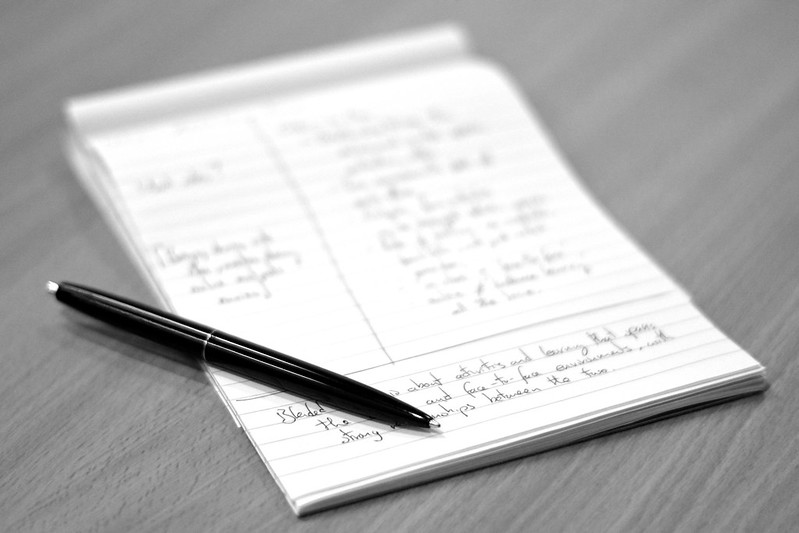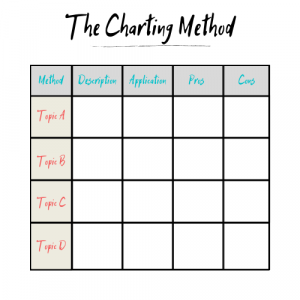8 Note-taking Skills
The capacity to take and organise notes during lessons, for research and assessments, and for exam preparation is a key academic writing skill.
This chapter will cover why, when, where, what, and how to take notes.
Why?
No student has ever reached the end of a term or semester and said “gee, I’m really glad I didn’t bother taking any notes”. Note-taking is a key strategy for organising information, ideas, and what you have learned in a chronological and systematic way that can be reviewed later. Humans are not physically or neurologically wired to remember vast amounts of information long-term (unless of course you are one of the extremely rare individuals with an eidetic memory). Also, the more senses you actively use while learning, the more likely you are to remember the information, therefore, writing (or typing) engages another part of your mind.
When?
The short answer is ALWAYS. Every lesson, lecture, library session; every time you engage in a learning activity. The fact is, you won’t know exactly what you’ll need until further down the track and it’s too late when you’ve arrived at the end of the study period and you realise that you haven’t captured enough information to refresh your memory before the big exam or assessment is due. Playing catch-up can be very stressful.
Where?
Part of good note-taking is making your notes accessible. Design specific files on your computer or device desktop or have designated partitions in a notebook. Divide your notes into weekly lectures, tutorials, assessment research, further reading. For example, if you have an assessment that involves the weekly readings or materials from weeks 1-5 of the term, then you should know exactly where to locate those materials on your device or in your notebook. It sounds like common sense, but you might be surprised how many students quickly develop poor organisation of their notes.
What?
Important points or key ideas will generally be repeated by your teacher. They will show up on power points or in readings. Use your teachers’ speech and body language cues to identify when a point is being stressed. It is physically impossible to type or write every word that a teacher says because on average they speak about 125 words a minute. That is why it is important that you identify the key points and record them.
How?
There is no one correct method to record notes. There is only the right method for you. Choose something that works for you and develop consistency. However, here are three popular methods:
Cornell Method

In the Cornell Method the page is quickly divided into a 30:70% split. This can be done prior to class or as the class gets underway.
At the top (Title section) record the date, course/subject, and teacher/lecturer.
To the right, record the key information from the lesson or lecture. Remember to watch and listen for cues from the teacher and/or power point.
The left-hand side and summary section are used after class to help commit the information to memory and to review the lesson prior to next class.
Writing questions in the left-hand column helps to clarify meanings, reveal relationships, establish continuity, and strengthen memory. Also, the writing of questions sets up a perfect stage for exam-studying later[1].
Summarising the class notes into your own words will create a quick reference guide for exams and help you retain valuable knowledge.
As you can see, the right-hand column has the key content as presented by the teacher/lecturer (made in dot-point form). The left-hand column has your thoughts and reactions to these ideas. Once you have had a chance to review the content and how it fits together, the summary at the bottom shows that you have mentally digested the key content and can put it accurately into your own words – a very powerful learning tool.
Mapping

Also known as concept mapping, this technique creates a visual representation of information and ideas in an organised way. It is a great way of making connections between concepts and demonstrating intertextuality and contextual relationships. It can be very helpful when trying to analyse or break down larger concepts into key features and supporting elements. Watch this quick video to learn more:
Charting

The charting method provides a systematic overview of your notes. The page is split into rows and columns (a table), and labelled. While this method requires some additional preparation time before your lesson, consider making up a simple word document that can be edited and adapted for your purposes. You might find it saves time during class as you can quickly categorise information as you hear or see it. It also transforms into a quick reference guide when it is time to study for your exams.
The charting method is also very useful for synthesizing large amounts of information that is compared across different sources (e.g., topics, theories, readings, approaches, experts). Your job at the start is to determine the best categories to compare and contrast the sources (see blue-green words in diagram).




- Cornell University: Learning Strategies Center. (2019). The Cornell note-taking system. http://lsc.cornell.edu/notes.html ↵
photographic
signal
hint
the interrelationship between texts;
the way different texts are similar or related, or different to each other

